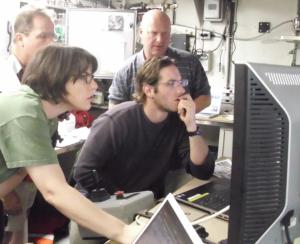“You get to go on a two-week cruise for vacation!”

One of the many data-filled screens that Erich, Ben, and Tim use to pilot TowCam.
This is the misconception that some people had, when I told them initially that I would be participating as a Teacher at Sea. On a vacation cruise and a research cruise, participants stay an extended period of time on the ocean, and they receive three meals a day. That is pretty much the end of the similarities between these types of cruises. During a scientific research expedition, there is a mission to accomplish. For example, this trip is examining sites that are known or predicted to be deep-sea coral and sponge habitats.
Many multibeam bathymetric maps are consulted to find the most suitable sites to investigate. Bathymetric maps are similar to topographic maps with the exception that bathymetry applies to the topography of the ocean floor. Most of the major structure-forming deep-sea corals are found on hard substrate. Thus, areas of soft sediment are not the most likely places to find the majority of coral species, however many other organisms like brittle stars and anemones, may be found there.
There is a lot of preparation that goes into planning and coordinating a research “cruise.” The Chief Scientist must put in a request for a research vessel, and must assemble a science crew that has the skills and research interests that align with the research mission. In the months leading up to the research trip, the science party will discuss specific science objectives, protocols and potential study sites. Every participant must receive medical clearance, which includes having a TB (tuberculosis) test, and a recent tetanus vaccination.
The Chief Scientist, with input from the science team, determines which areas of the ocean to examine, and what type of technology to use to explore the ocean. Weather and waves may prevent some of the “dives” from taking place. Safety first – the conditions must be safe enough for the TowCam operators and deck crew to be outside during deployment as they lower TowCam safely into the ocean.
During TowCam deployments, many things must be done to make the dive successful. The Chief Scientist selects several points (waypoints) along a survey line within a canyon. These points help guide the ship during the TowCam deployment. To get TowCam into the water requires a lot of communication and coordination of efforts. The winch operator and deck crew are responsible for getting TowCam into the water. The winch operator is in constant contact with the TowCam pilot and controls the wire that lowers TowCam into the water. At a certain depth, the control is passed to the TowCam pilot in the lab who uses a joystick to lower the camera to the ocean floor. The pilot and the Bridge are in constant communication during the dive. The Bridge controls the ship and follows the track for the survey. The TowCam pilot analyzes data displayed on several computer monitors in order to make the most informed decisions as they guide the camera through the water column by moving TowCam and up and down in the water column. In addition, a variety of data are collected during the deployment. I have been logging data during the night shift deployments. I help keep track of variables such as depth, winch wire tension, latitude, longitude, and altimeter readings along the survey track. All this information will be invaluable to scientists examining the data collected during this research cruise.

Entering data into the TowCam data log
Personal Log
At Crest Middle School, we try to teach our students critical thinking skills: think for themselves, make informed decisions, gather data, predict, and draw conclusions. This research trip is a prime example of how skills that students acquire in school will be beneficial for them in the future. When completing a task such as logging data, I have to decide what the important events are that have occurred in the TowCam dive, and to phrase those items in a way that others will understand.
Did You Know?
TowCam is about the size of a refrigerator. It has one large high-resolution camera that takes pictures every 10 seconds. It also has a CTD, which records conductivity (salinity), temperature, and depth. TowCam also carries several Niskin bottles, used for water collection at depth and a slurp pump that pulls sediment from the ocean floor into a container for later analyses.






